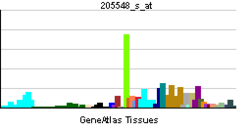BTG3
Protein BTG3 is a protein that in humans is encoded by the BTG3 gene.[3][4]
The protein encoded by this gene is a member of the BTG/Tob family. This family has structurally related proteins that appear to have antiproliferative properties. This encoded protein might play a role in neurogenesis in the central nervous system.[4]
References
Further reading
- Matsuda S, Rouault J, Magaud J, Berthet C (2001). "In search of a function for the TIS21/PC3/BTG1/TOB family". FEBS Lett. 497 (2–3): 67–72. doi:10.1016/S0014-5793(01)02436-X. PMID 11377414.
- Guéhenneux F, Duret L, Callanan MB, et al. (1997). "Cloning of the mouse BTG3 gene and definition of a new gene family (the BTG family) involved in the negative control of the cell cycle". Leukemia. 11 (3): 370–5. doi:10.1038/sj.leu.2400599. PMID 9067576.
- Hattori M, Fujiyama A, Taylor TD, et al. (2000). "The DNA sequence of human chromosome 21". Nature. 405 (6784): 311–9. doi:10.1038/35012518. PMID 10830953.
- Birot A, Duret L, Bartholin L, et al. (2000). "Identification and molecular analysis of BANP". Gene. 253 (2): 189–96. doi:10.1016/S0378-1119(00)00244-4. PMID 10940556.
- Yoshida Y, Hosoda E, Nakamura T, Yamamoto T (2001). "Association of ANA, a member of the antiproliferative Tob family proteins, with a Caf1 component of the CCR4 transcriptional regulatory complex". Jpn. J. Cancer Res. 92 (6): 592–6. doi:10.1111/j.1349-7006.2001.tb01135.x. PMID 11429045.
- Strausberg RL, Feingold EA, Grouse LH, et al. (2003). "Generation and initial analysis of more than 15,000 full-length human and mouse cDNA sequences". Proc. Natl. Acad. Sci. U.S.A. 99 (26): 16899–903. doi:10.1073/pnas.242603899. PMC 139241
 . PMID 12477932.
. PMID 12477932.
- Gerhard DS, Wagner L, Feingold EA, et al. (2004). "The Status, Quality, and Expansion of the NIH Full-Length cDNA Project: The Mammalian Gene Collection (MGC)". Genome Res. 14 (10B): 2121–7. doi:10.1101/gr.2596504. PMC 528928
 . PMID 15489334.
. PMID 15489334.
- Rual JF, Venkatesan K, Hao T, et al. (2005). "Towards a proteome-scale map of the human protein-protein interaction network". Nature. 437 (7062): 1173–8. doi:10.1038/nature04209. PMID 16189514.
- Lim J, Hao T, Shaw C, et al. (2006). "A protein-protein interaction network for human inherited ataxias and disorders of Purkinje cell degeneration". Cell. 125 (4): 801–14. doi:10.1016/j.cell.2006.03.032. PMID 16713569.
- Ou YH, Chung PH, Hsu FF, et al. (2007). "The candidate tumor suppressor BTG3 is a transcriptional target of p53 that inhibits E2F1". EMBO J. 26 (17): 3968–80. doi:10.1038/sj.emboj.7601825. PMC 1994125
 . PMID 17690688.
. PMID 17690688.


 . PMID 12477932.
. PMID 12477932. . PMID 15489334.
. PMID 15489334. . PMID 17690688.
. PMID 17690688.